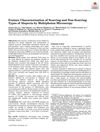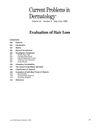TLDR The document suggests that the traditional understanding of hair growth cycles and alopecia may be inaccurate and that blood supply plays a significant role in hair growth and loss.
The document examines the relationship between hair growth, hair loss, and blood supply to hair follicles, highlighting Dr. Cormia's improved technique using toluidine blue staining alongside alkaline phosphatase reaction to better visualize the vasculature. It questions the accuracy of the commonly cited 1,000-day hair growth cycle, suggesting it may be too short, and notes that losing fewer than 100 hairs per day is normal. Additionally, it discusses the link between the growth activity of hair follicles and skin, and the possibility of a single vessel supplying both growing and resting hairs. The document also includes Dr. Epstein's challenge to the belief that alopecia areata does not occur in individuals with gray hair, citing a case of a 48-year-old man with gray hair who developed the condition.
 33 citations
,
September 1961 in “Archives of Dermatology”
33 citations
,
September 1961 in “Archives of Dermatology” Colchicine causes rapid hair loss by damaging hair follicles.
23 citations
,
September 1957 in “Archives of Dermatology” Alkaline phosphatase activity decreases in early alopecia areata.
 1 citations
,
September 2022 in “Journal of The American Academy of Dermatology”
1 citations
,
September 2022 in “Journal of The American Academy of Dermatology” Baricitinib helps grow eyebrows and eyelashes in severe alopecia areata patients.
 24 citations
,
September 2018 in “Lasers in Surgery and Medicine”
24 citations
,
September 2018 in “Lasers in Surgery and Medicine” Multiphoton microscopy can non-invasively tell apart scarring from non-scarring hair loss and could aid in treatment.
 August 2018 in “Oxford University Press eBooks”
August 2018 in “Oxford University Press eBooks” The document's conclusion cannot be provided because the document cannot be parsed.
Trichotillometry can measure hair plucking force, aiding alopecia treatment evaluation.
 21 citations
,
May 1996 in “Current problems in dermatology”
21 citations
,
May 1996 in “Current problems in dermatology” Detailed patient history and physical exams are crucial for diagnosing hair loss.
July 1994 in “Archives of Dermatology” The book provides a thorough guide on hair and scalp diseases, covering causes, types, and evaluation methods.
189 citations
,
May 1991 in “Medical Entomology and Zoology”  5 citations
,
October 1988 in “Clinics in Dermatology”
5 citations
,
October 1988 in “Clinics in Dermatology” Minoxidil promotes hair growth but exact mechanism is unknown.






